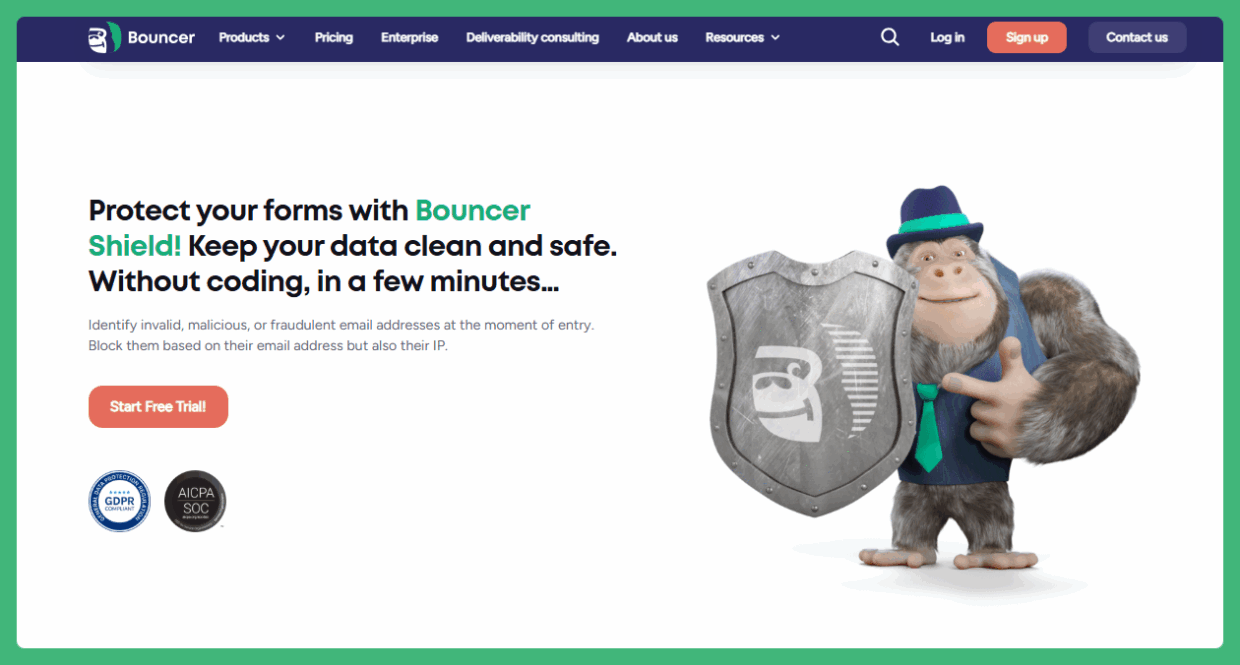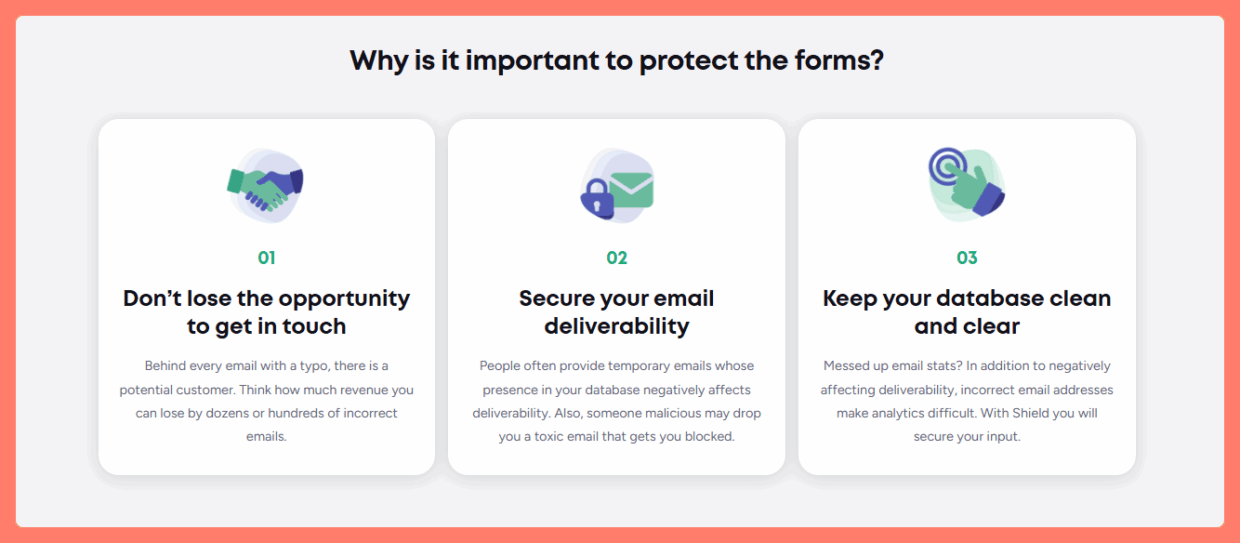If you’re running any kind of online business – SaaS, e-commerce, blog, newsletter – you already know: validate email addresses, or brace yourself for chaos. So what does email field validation really do?
In theory, it’s your first (and sometimes only) line of defense against invalid email addresses, spammy submissions, and data that’s about as useful as a chocolate teapot. In practice, it’s the difference between a database full of active subscribers and one riddled with non functional email addresses, typos, and disposable domains that only exist for 10 minutes.
Why bother with email validation at all?
Look, there’s a reason why all decent sign up forms run their email addresses through the wringer. Here’s what’s at stake if you just let any address through the gates:
- Lost connections: Every invalid email address is a missed opportunity. Behind every typo (“gnail.com”) or bad copy-paste lurks a real, possibly paying, customer who now will never see your onboarding, promo, or “here’s your discount code” email.
- Wasted money and effort: Nothing says “marketing budget down the drain” like launching email campaigns at non-existent recipients, invalid addresses, or entire mailing lists full of ghosts.
- Ruined sender reputation: Send enough mail to invalid or disposable email addresses and, soon, your domain’s reputation is circling the drain. ISPs are unforgiving—keep sending to spam folders or bouncing, and you’ll be locked out faster than you can say “mail server.”
- Messy analytics: Try running a campaign report with 25% of your database being “test@test.com” or “qwerty@123.com.” The results are, predictably, a dumpster fire.
Let’s break down the email validation process
Email field validation isn’t one thing; it’s a series of steps, each with its own job to do. Good validation checks more than just “is there an @ sign somewhere in here?”
1. Syntax check: the first line of defense
Start simple. Before you let an address through, make sure it’s a properly formatted email address. That means:
- No missing @ symbol.
- No invalid characters (looking at you, spaces, slashes, and question marks).
- A local part (everything before the @) that actually contains alphanumeric characters.
- A domain part (everything after the @) that’s a valid domain, not “.pizza” or “.asdf.”
- A top level domain (TLD) that exists. “kinga@unicorn.shoes” might sound cute, but unless you sell magical footwear, it’s probably wrong.
Here’s where a regular expression or a tool like Apache Commons Validator comes in handy. But don’t just stop at syntax—syntactically correct doesn’t always mean real.
2. Obvious errors and helpful error messages
Humans are creative, especially when typing fast. “gmial.com,” “outlok.com,” “yaho.co”—all common formatting errors. Smart email validators catch these and serve up helpful error messages (“Did you mean gmail.com?”), rather than the dreaded “Invalid format” that just annoys users. Tools like Claspo let you pair such validation with user-friendly popups and signup templates, ensuring the entire form experience feels seamless.
3. Domain verification: does this domain even exist?
Okay, so the address looks right. Now, is the domain real? Here’s where domain verification steps in. Is there a DNS record? Does the domain have MX records (mail exchange servers) set up to receive messages? If the answer is no, you’re dealing with a non-existent domain part, so kick it out. No point in storing “kinga@totallyfakewebsite.lol.”
4. MX record check: can it actually receive email?
Having a domain isn’t enough. Your validator should check if the MX record is set up—because without one, even a valid domain won’t actually receive emails. You want to validate email addresses that are real, not ones that vanish into the ether.
5. Block disposable and temporary addresses
Disposable email domains (think “mailinator.com,” “10minutemail.com”) are the bane of any marketer’s existence. Sure, they’re valid for a hot minute, but they’re useless for follow-ups, marketing, or… anything, really. A decent validator will spot these and eliminate invalid entries.
6. Double opt-in: the ultimate insurance
Let’s face it, even the best validator can’t guarantee a human being at the other end. Double opt-in—that is, making users click a link in an email to confirm—is how you can finally sleep at night, knowing the address is real and owned by the intended recipient.

Real-time feedback: catching errors before they snowball
There’s nothing more satisfying (and more effective) than real-time feedback on your sign up forms. As users type, your email validator should nudge them away from disaster.
Missed @? “Looks like you forgot the @ symbol.” Extra space at the end? “Obvious error—please check your email format.” Invalid characters? “Only alphanumeric characters and dots are allowed.” Nobody likes submitting a form three times just to get past a mysterious “invalid email” error.
What happens when you don’t validate emails?
Imagine launching a killer campaign, only for half of your emails to bounce because you didn’t weed out inactive addresses. Your sender reputation tanks, your domain gets flagged for spammy behavior, and soon your perfectly-crafted email messages are buried in spam folders everywhere.
Or, let’s say you run a SaaS and all your analytics are built around onboarding flows. Now 20% of your form submissions are invalid. Suddenly your funnel metrics are garbage, and your product manager is wondering why everyone signs up but nobody logs in.
The secret villains: spam bots, typos, and the “just here for the coupon” crowd
Not every invalid email is an honest mistake. Bots love nothing more than to fill your sign up forms with a blend of nonsense and real addresses, hoping to get through. Some users hand over temporary email addresses just to grab a free trial, then vanish.
And then there are the typos—innocent, well-meaning, but just as damaging. If you don’t catch these at the point of entry, you’re stuck forever wondering why “john.smith@gnail.com” never opens a single email.
The Bouncer Shield way: simple, strong, and no code required
Cue the superhero music: Enter Bouncer Shield.

If you don’t want to mess around with code, DNS lookup tools, or manually cross-referencing the list of disposable email domains, Bouncer Shield swoops in.
How does it work?
- Configure: Decide what kinds of addresses (and IPs) you want to block. Disposable? Malicious? Typos? All of the above?
- Install: Paste a simple script on your website. No need for developer tears or long hours in the docs.
- Forget: Sit back as Bouncer automatically eliminates invalid addresses and keeps your form submissions sparkling clean.

Even better, you can customize the look to match your brand, hide the “Powered by Bouncer” logo, and manage everything with a user friendly dashboard. Want advanced styling? Roll out your custom CSS. Local currencies, easy cancellation—yep, they thought of that.
The not-so-hidden perks of proper email field validation
Let’s sum up why every marketer, dev, or founder should treat email field validation like a must-have, not a nice-to-have:
- Better deliverability: Reach actual inboxes, not spam folders.
- Cleaner lists: No more mailing lists cluttered with fake, inactive, or temporary addresses.
- Happier users: Nothing kills a relationship faster than a “missed email” thanks to a typo.
- Solid sender reputation: Stay in the good graces of email service providers and mail servers everywhere.
- Actionable analytics: Make decisions with confidence, knowing your data isn’t polluted with junk.
- Protection against fraud: Stop spammy behavior and malicious actors at the gate, not after they’re inside.
Tip: Use Bouncer for the best protection for your email addresses.

Witty, but let’s get practical: best practices for your email field
If you’re serious about validation (and, by now, you really should be), here’s the punchline:
Use a reputable email validator (your regex is not enough)
Think running a quick “does this string have an @ sign?” check counts as email verification? Think again. A proper validator dives far deeper—running DNS lookups, checking for active MX records, and filtering out the endless parade of disposable domains.
You want a verification process that doesn’t just confirm if the email address syntax looks right, but actually asks: “Does this email address exist? Is there an email server ready and willing to accept messages?”
When you skip these checks, you’re rolling out the red carpet for a flood of addresses that will never see a successful email delivery.
Email marketers who settle for half-baked validation wind up with data full of ghosts and bounce-backs. Instead, use a tool that checks the entire email address, not just the bits around the @.
Give real-time feedback (don’t wait for disaster)
Ever filled in a form, hit submit, and been blindsided by a bland “invalid email” message? That’s a conversion killer. Instead, your forms should run the verification process as your user types, catching errors instantly.
Flag email address syntax mistakes (“missing @,” “spaces are not welcome here,” “double dots in a row? Absolutely not!”) right away. Suggest corrections for common typos, and—if you’re feeling generous—point out suspicious domains that could tank your email deliverability. This isn’t just about user experience; it’s about keeping your database packed with valid email addresses before they sneak past the velvet rope.
Real-time feedback saves time for everyone: users fix their mistakes on the spot, and you dodge a list full of addresses that don’t work for email marketing campaigns. Win-win.
Block temporary email addresses (no more 10-minute wonders)
If you’re running a promo, a contest, or a free download, you’ll meet the dark side of the internet: disposable emails. These are addresses that work long enough to grab your lead magnet, then vanish into thin air. Sure, such addresses look like a valid email address during sign-up—but try reaching them next week.
Quality email providers flag these, but many slip through basic checks. Use an email validator that recognizes disposable domains and blacklists them before they sneak onto your list.
Why waste money, time, and a precious spot in your database on such addresses? Blocking them at the door protects your email deliverability, helps maintain a good sender reputation, and ensures your email marketing campaigns go to actual humans—not bots or coupon chasers.
Send a double opt-in confirmation (the gold standard)
Think of double opt-in as your insurance policy. Even if an address looks squeaky clean and passes every email verification check, you still don’t know if the email address exists—or if the user is just playing you with a typo.
A double opt-in sends a confirmation email and only adds users to your list when they click the link. This step confirms the address is real, the person behind it wants your emails, and your next campaign won’t land in the abyss. It’s a small hurdle for your audience, but a huge leap for your good sender reputation and successful email delivery.
For email marketers, this practice is the holy grail: it guarantees that everyone on your list is not just real, but actually interested. If you want to avoid spam traps and boost your open rates, you simply can’t skip it.
Don’t get too clever with format restrictions (embrace proper syntax)
Emails are more complex than most people realize. The entire email address can legally include plus signs, dots, hyphens, and even some surprising symbols. Overly aggressive format rules often block valid email addresses—annoying legitimate users and shrinking your list for no reason.
Stick to proper email address syntax. Use up-to-date validation libraries that understand the full range of what’s acceptable. Don’t throw out addresses just because they look a bit unusual.
After all, plenty of people use clever tricks with their addresses to organize mail (“kinga+newsletters@gmail.com” is a classic). Don’t ban such addresses—welcome them, and your email marketing campaigns will reach their intended recipients without a hitch.
Customize your error messages (banish “invalid email” forever)
Nobody wants to be told, flatly, that their email is “invalid.” That’s not just boring—it’s unhelpful.
Tailor your error messages to tell users why their address failed the verification process.
- “Please enter a valid email address (e.g., you@yourdomain.com).”
- “It looks like you missed the @ symbol.”
- “We can’t find an email server for that domain—did you mistype it?”
- “Temporary emails aren’t accepted. Please use your primary address.”
This not only increases your conversion rates, it also keeps your users happy. Clarity here means you collect more valid email addresses, reduce failed form submissions, and keep your list ready for successful email delivery. Even better, it demonstrates that you care about getting things right—a small but meaningful signal that improves trust with both users and email providers.
Common pitfalls (and how to dodge them)
- Relying solely on regex: Regular expressions are powerful, but they won’t catch invalid domains, inactive addresses, or addresses that can’t receive messages.
- Forgetting about international domains: Plenty of valid emails have non-Latin characters or country-specific TLDs. Don’t block users from outside your home country.
- Not updating your disposable domain list: New temporary email services pop up daily. Use a validator that keeps its blocklist fresh.
- Ignoring domain reputation: Some domains are notorious for spammy behavior. Spot them early, keep your mailing lists clean.
Wrap-up: validation isn’t optional. It’s survival.
In 2025, nobody should be running web forms without strong email field validation. It’s not just about having a properly formatted email address—it’s about making sure your users are real, your campaigns hit the mark, and your sender reputation stays squeaky clean.
Stop losing sleep over spam complaints, wasted email campaigns, and messy analytics. Protect your forms with a solution like Bouncer Shield, where a few minutes of setup saves you from a world of pain down the line.
So go ahead: validate, verify, and—most importantly—keep your database full of valid emails, not empty promises.
Want to see what bulletproof email field validation feels like?
Start your free trial with Bouncer Shield.
Because, honestly, your email list deserves better than “asdf@asdf.com.”


